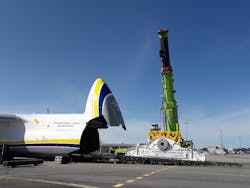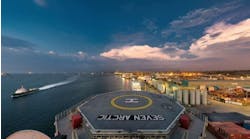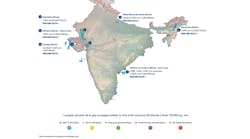Offshore staff
SOUTHAMPTON, UK – Oil Spill Response Ltd. (OSRL) has for the first time completed an air transport test flight of a fully assembled subsea capping stack.
Following studies with the Subscribers Technical Advisory Forum (STAF), OSRL had examined various options to reduce capping stack mobilization response times, including an assessment of alternative air freight capping stacks and newbuild proposals.
BP led a STAF working group to investigate and develop the best technical solution for the air freight service, deemed to be speeding up mobilization of the existing OSRL capping stacks (developed via the industry’sSubsea Well Response Project).
For the members, a critical factor was said to be the compatibility of capping stacks with OSRL’s containment solution and offset installation system.
Following a logistics study by Chapman Freeborn, examining the members’ areas of operations, the AN-124 was chosen as the most suitable airframe.
This was due to its payload capacity - travel of up to 5,000 km (3,107 mi) with a 120-metric ton (132-ton) payload; self-loading/off-loading capabilities (allaying concerns over airport deck loader capacity); and availability on the European spot market.
OSRL worked with L+M to design and fabricate a bespoke frame, with original equipment manufacturerTrendsetter providing support for the capping stacks. Antonov Airlines and Volga Dnepr both reviewed and approved the combined skid/capping stack design and physical load for flight.
Prior to the mobilization exercise and test flight at Sola Airport, 10 km (6.2 mi) from OSRL’s base in Tananger, southwest Norway, transporting the equipment by air would have required the 85-metric ton capping stack to be broken down into multiple payloads and delivered on various Boeing 747 (or equivalent) transport planes, before being reassembled at the destination and moved to the incident site.
Chris Lund, technical manager for OSRL’s SWIS team, said: “The number one priority is stopping the flow of hydrocarbons as quickly as possible. The ability to transport a fully assembled capping stack by air is a critical development for the industry.
“Sea transport remains the most likely mobilization option for the majority of well sites, which is why we have four capping stacks strategically located in key upstream regions – fully assembled at storage bases with direct quayside access.
“But for wells in more remote areas, and for members looking to secure drilling licenses in new or remote exploration locations, this is a vital addition to our subsea capping and containment offering.”
09/05/2018



